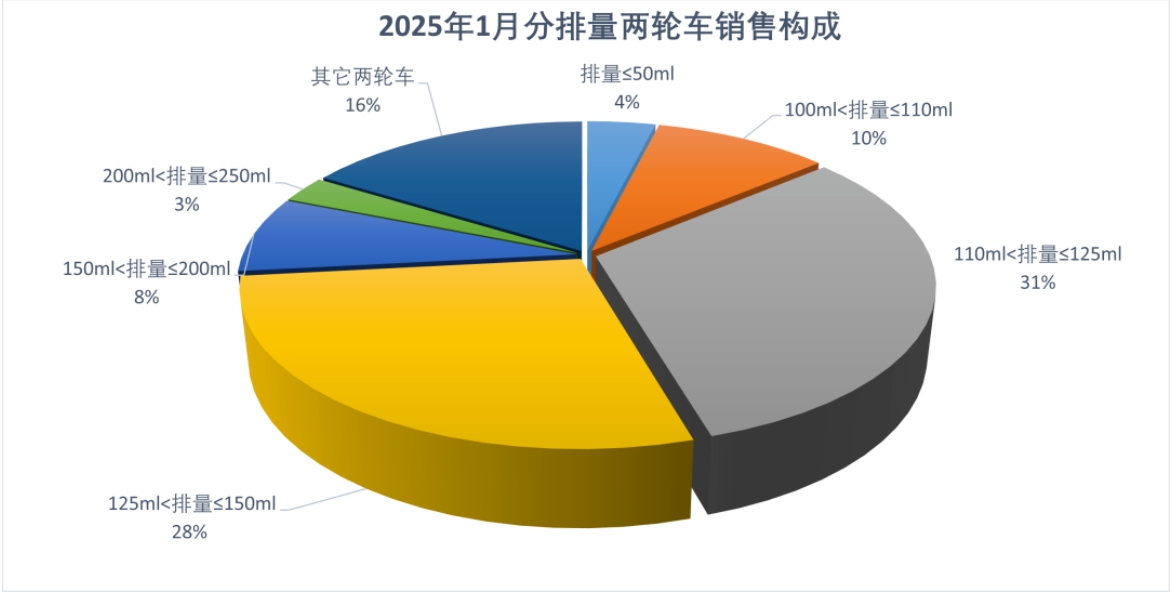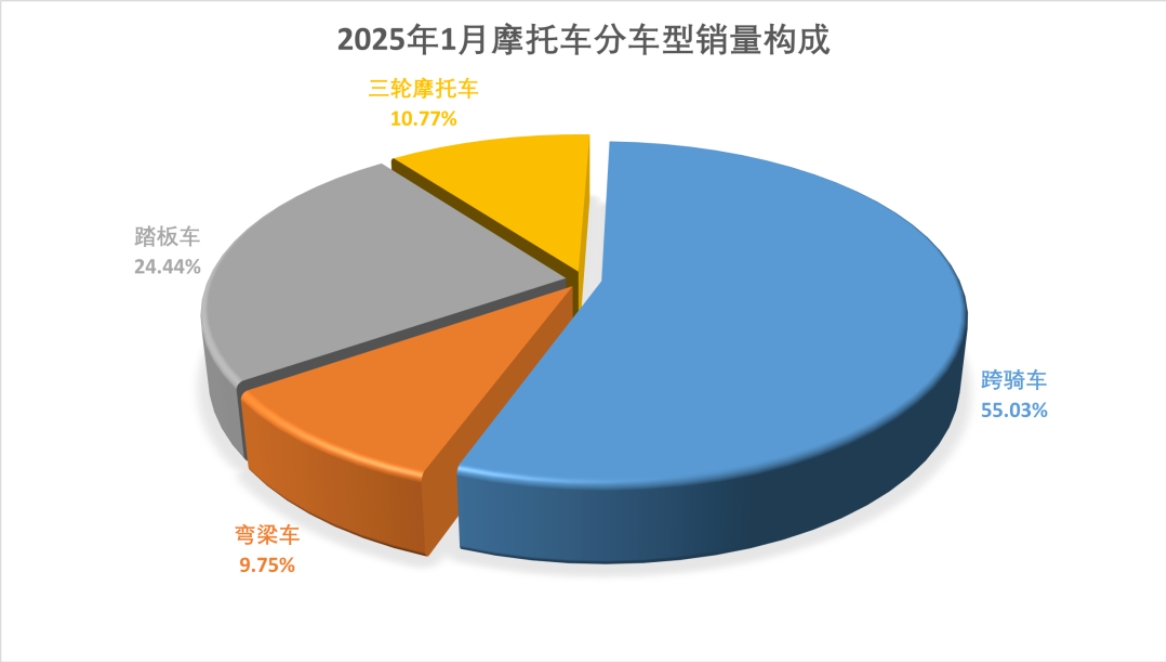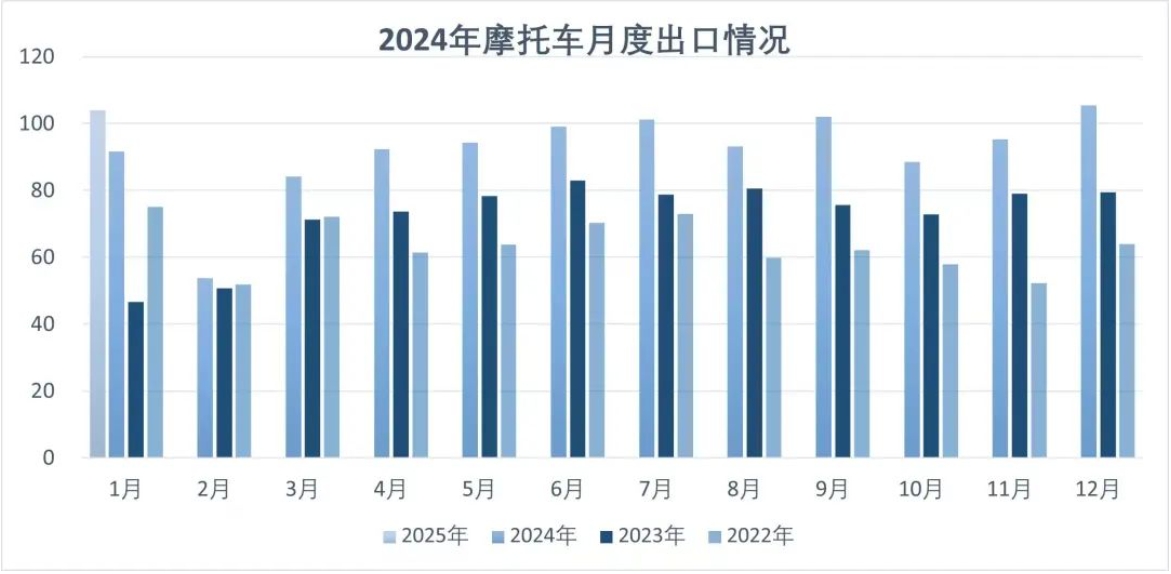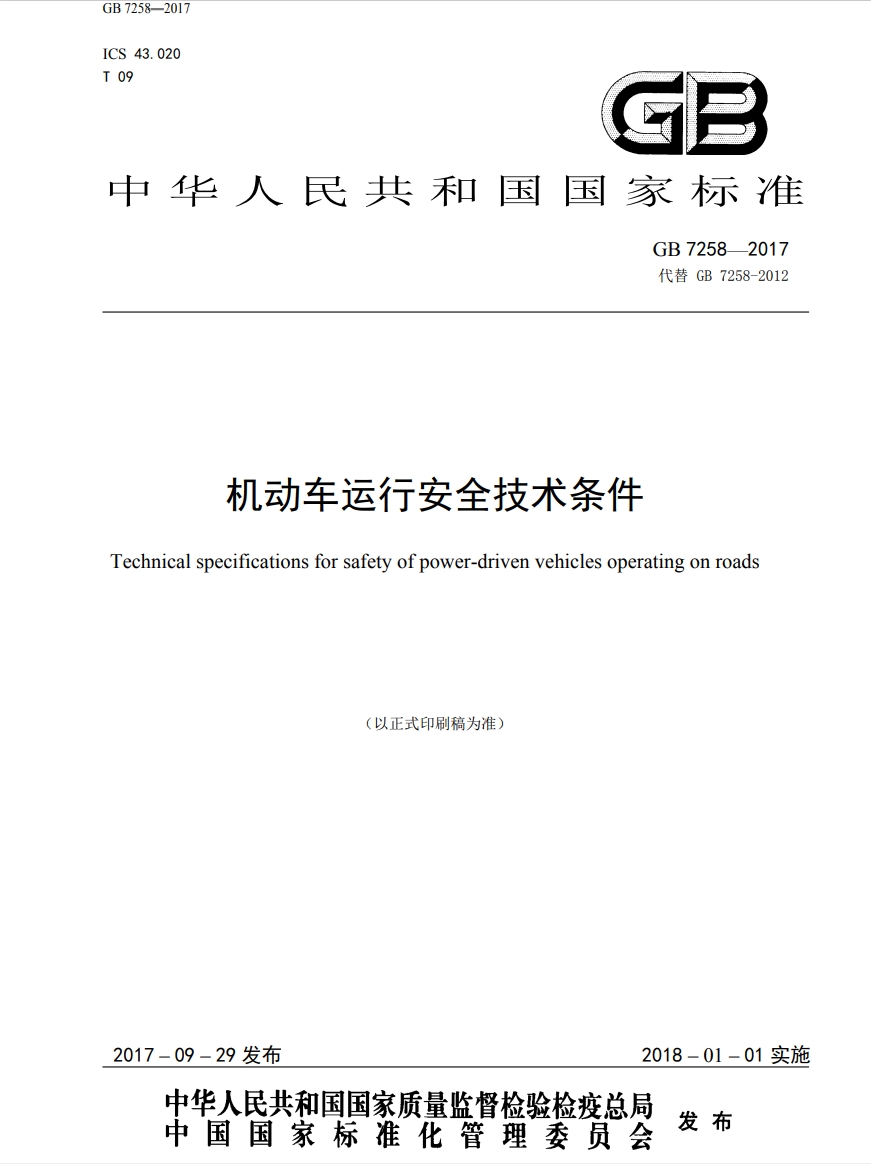28
2025
-
02
China Industry News: 2025 China Motorcycle Industry Outlook: Will Continue to Show Mild Growth Trend
Author:
China Industrial Reporter Qi Xiaoling
On February 21, the latest data released by the China Motorcycle Association shows that the total production and sales of motorcycles in China will reach 1.5975 million units in January 2025, a year-on-year increase of 2.1%, with exports reaching 1.0404 million units, a year-on-year increase of 13.56%. Despite a slight decline in production and sales month-on-month due to the early Spring Festival holiday, the production and sales of large-displacement leisure motorcycles surged by over 50% year-on-year, and the export value exceeded 659 million USD, injecting strong momentum into the industry's development.

The Central Economic Work Conference systematically deployed economic work for 2025, providing support for the sustained recovery and improvement of the economy with a more proactive policy tone, effectively boosting market confidence and expectations. After the Spring Festival, the first State Council meeting clearly placed the promotion of consumption in a more prominent position, and relevant national ministries and commissions actively implemented the central deployment. In this context, can the motorcycle market continue its growth trend? Can consumption upgrades and export dividends effectively offset cost pressures and the bottlenecks of electrification? The China Industrial Reporter conducted interviews with professionals based on January data and industry trends.
Breakthrough in high-end development, pressure on electrification
According to statistics from the China Motorcycle Association, in January 2025, the production and sales of the motorcycle industry in China were 1.5719 million and 1.5975 million units, respectively, a month-on-month decrease of 10.56% and 9.14%, and a year-on-year increase of 1% and 2.1%. "The recovery of fuel vehicles and the cooling of electric vehicles" has become the main market characteristic at the beginning of the year, showing a significant differentiation in the motorcycle industry.
Fuel motorcycles have become the main driving force for growth, with production and sales in January reaching 1.3648 million and 1.383 million units, a year-on-year increase of 2.68% and 2.77%. In contrast, electric motorcycles had production and sales of 207,100 and 214,400 units in January, with month-on-month declines of 24.13% and 19.11%, and year-on-year declines of 8.78% and 2%. The competition in the electric motorcycle market has intensified, falling into difficulties right from the start. This differentiation phenomenon not only reflects the direct impact of policy withdrawal but also indicates structural changes in the consumer market.

From the perspective of the segmented market, two-wheeled vehicles performed prominently. In January, the production and sales of two-wheeled vehicles were 1.4076 million and 1.4254 million units, respectively, with month-on-month declines of 10.55% and 6.16%, but year-on-year increases of 2.72% and 3.44%. Among them, the market shares of cross motorcycles, scooters, and step-through motorcycles were 61.68%, 27.39%, and 10.93%, respectively. In terms of model types, cross motorcycles ranked first in the two-wheeled vehicle market with sales of 879,100 units and a market share of 61.68%, a year-on-year increase of 13.8%; while scooters saw a year-on-year decline of 14.91% in sales due to rising raw material prices squeezing profit margins, further shrinking their market share.

It is worth noting that under the trend of consumption upgrades, large-displacement leisure motorcycles (displacement above 250cc) have become the biggest beneficiaries in the market, with production and sales in January showing significant year-on-year growth of 63.87% and 52.85%. Li Bin, Executive Vice President of the China Motorcycle Association, pointed out that as consumers' pursuit of a high-quality life continues to rise, the large-displacement motorcycle market is gradually expanding. At the same time, the younger consumer group has an increasing sense of identity with riding culture, and the demand for high-end models that combine high performance and social attributes continues to be released.
Zhang Hongbo, Secretary-General of the China Motorcycle Association, analyzed that this data intuitively reflects the sustained growth of demand in the high-end market under the trend of consumption upgrades. Consumers' demand for motorcycles is no longer limited to basic transportation functions but is more inclined to pursue high-end products that offer leisure, entertainment, and personalized experiences.
In terms of three-wheeled motorcycles, production and sales in January were 164,300 and 172,000 units, respectively, with month-on-month declines of 31.97% and 28.08%, and year-on-year declines of 11.62% and 7.78%. Among them, ordinary cargo three-wheeled vehicles had production and sales of 133,100 and 138,400 units, with month-on-month declines of 28.82% and 24.62%, and year-on-year increases of 12.37% and 9.84%; ordinary passenger three-wheeled vehicles had production and sales of 29,500 and 32,000 units, with month-on-month declines of 43.96% and 40.44%, and year-on-year declines of 12.75% and 2.54%. The decline in the three-wheeled motorcycle market reflects the impact of the accelerated urbanization process and stricter environmental protection policies on this segmented market.

The speed of industry reshuffling is accelerating, with the top ten companies in fuel motorcycle sales accounting for 56.98% of the total, an increase of 1.2 percentage points compared to 2024, with leading companies like Dazhangjiang and Longxin occupying a dominant position. They stand out in market competition by leveraging advantages in brand, technology, and channels. In the electric motorcycle sector, Yadi leads with sales of 81,700 units, but the market share of the top ten companies is less than 50%, and small and medium-sized enterprises are still struggling to survive in the price war. Securities industry analyst Zhang Jun stated: "The electric motorcycle market, characterized by low technical barriers and severe homogenization, may face a new round of consolidation."
Continuous growth in exports, significant improvement in international competitiveness
Data shows that in January, China's motorcycle export volume reached 1.0404 million units, a year-on-year increase of 13.56%, with an export value of 659 million USD, a year-on-year increase of 11.13%. Despite a slight month-on-month decline due to the Spring Festival stocking cycle, the year-on-year growth rate is significant, continuing the high growth trend of exports in 2024. This achievement is attributed to the continuous investment and efforts of Chinese motorcycle companies in product quality, technological innovation, and brand building.

The trend of displacement upgrades is particularly evident in export data. Exports of large-displacement motorcycles (above 250ml) surged by 25.23% year-on-year, while the 200 series (150ml < displacement ≤ 200ml) saw a significant year-on-year increase of 70%. Li Bin believes this fully demonstrates the continuous enhancement of China's motorcycles' international competitiveness in the high-end market. "Companies have successfully opened the door to the high-end market by increasing R&D investment and improving product performance and quality. However, while the 125 series remains the main export force (317,200 units), its growth rate has slowed to 12.79%." Li Bin reminds companies that while consolidating traditional advantageous products, they must accelerate the pace of product upgrades.
It is understood that markets in Southeast Asia, the Middle East, and other "Belt and Road" regions have become the main driving forces for growth. Taking Vietnam as an example, in 2024, China's motorcycle export value to Vietnam increased by 22%, while in January 2025, the export volume of companies like Longxin and Dazhangjiang to ASEAN countries accounted for over 40%. In addition, the tariff reduction policies of the Regional Comprehensive Economic Partnership (RCEP) further reduced trade costs, boosting the profit margins of export companies by 0.8-1.2 percentage points.
The concentration of exports continues to increase, with the top ten companies (Longxin, Dazhangjiang, etc.) accounting for 61.79% of exports in January, an increase of 1.7 percentage points compared to 2024. Leading companies are accelerating the transition from "OEM" to building their own brands: Zongshen has established a research and development center in Indonesia, Chunjun Power has launched customized models for the European market, and Dazhangjiang is enhancing brand premium through sponsorship of international events. A foreign trade company executive stated: "Chinese motorcycles are no longer just 'cheap goods', but a comprehensive representation of technology, design, and service competitiveness."
Economic benefits are steadily increasing, and profitability is continuously enhancing.
In 2024, the motorcycle industry achieved outstanding results: the total industrial output value reached 132.491 billion yuan, a year-on-year increase of 8.76%; operating income was 143.071 billion yuan, a year-on-year increase of 9.72%; total profit was 9.231 billion yuan, a significant year-on-year increase of 13.02%, with the industry's average profit margin rising to 6.45%. Cost control optimization (management expenses decreased by 1.17%) and increased R&D investment (R&D expenses of 4.673 billion yuan, an increase of 5.33%) became key factors for profit improvement. This indicates that enterprises are actively transitioning to a technology-driven model, optimizing internal management processes, reducing management costs, and investing more resources in R&D to continuously enhance the technical content and added value of products to meet the needs of market competition.
From the enterprise level, the top ten companies accounted for 62.62% of revenue, with six companies including Zongshen and Longxin experiencing revenue growth, but profit growth was mainly concentrated in five companies including Longxin and Chuncheng Power, leading to increased differentiation in development among enterprises. This indicates that despite the overall positive environment in the industry, development among enterprises is not balanced. Leading companies, leveraging their advantages, perform outstandingly in revenue and profit growth, while some companies face challenges such as intensified market competition and compressed profit margins. Meanwhile, small and medium-sized enterprises are under dual pressure from rising raw material costs (aluminum prices rose by 12% year-on-year in 2024) and upgraded environmental standards (implementation of National IV emission standards), with some companies having profit margins of less than 3%. Zhang Hongbo, Secretary-General of the China Motorcycle Association, stated: "The industry is shifting from 'scale expansion' to 'quality competition', and companies lacking technological reserves will be eliminated."
Market competition is becoming increasingly fierce, with price wars and technological iterations.
In the motorcycle market in January, the launch of new vehicles became the focus of consumer attention. Major domestic and international brands launched new models, injecting new vitality into the market.
In terms of international brands, the Indian brand's 2025 new Scout series, launched in April 2024, has attracted much attention. This series is positioned as a cruiser bike, equipped with a V-twin SpeedPlus engine that can produce 110 horsepower and 109 Nm of torque, with a displacement of 1250cc and a compression ratio of 12.5:1, providing strong power. The new steel tube frame design not only enhances the overall performance of the vehicle but also gives it a more sporty appearance. The seat height is only 680 millimeters, making it more accessible for riders of different heights. Among them, the 101 Scout is the only model that uses dual front brake discs, with adjustable front and rear suspension, equipped with inverted front forks and dual rear shock absorbers, providing riders with a more comfortable and stable riding experience. Its price of approximately 147,000 yuan also highlights its high-end positioning, further enriching the choices in the large-displacement leisure motorcycle market and meeting consumer demand for high-quality cruising motorcycles.
Domestic brands also performed well, with the KAWASAKI findert250x emerging in the market. This bike has attracted the attention of many consumers with its unique design and high cost-performance ratio. Harley-Davidson also brought surprises in January 2025, unveiling part of its new motorcycle series for 2025 on its official website and selling them through authorized dealers worldwide. In addition, Harley-Davidson has specially launched three factory-customized paint and pattern design schemes for specific models, catering to consumers' pursuit of personalized appearances. For example, the Phantom Blue paint can present dynamic color changes from deep gray metallic to purple, blue, and then to a color close to orange, which is particularly charming under sunlight, adding more fashion and personality elements to Harley's classic models.
In addition to new vehicle launches, price strategy adjustments in the market have also attracted widespread attention. Brands like Honda adopted price reduction strategies in January, which quickly resonated in the market. The price-reduced Honda motorcycles have significantly improved in cost-performance ratio, attracting more consumer attention, especially from potential buyers who are sensitive to price. This strategy not only helps Honda boost sales in the short term but also impacts the competitive landscape of the entire market. Other brands, in response to Honda's price cuts, have begun to reassess their pricing systems and market strategies; some brands may follow suit with price reductions, while others may maintain their competitiveness by enhancing product configurations and strengthening After-sale Service.
Consumer demand for motorcycles is rapidly developing towards diversification and personalization, a trend that is particularly evident in the market performance of January 2025. Consumers' demand for motorcycles is no longer limited to basic transportation functions but is increasingly focused on personalization, quality, and entertainment. The high popularity and purchase intention of racing models indicate consumers' pursuit of speed, passion, and personalized appearances; the rapid growth of the large-displacement leisure motorcycle market also reflects consumers' yearning for high-quality leisure riding experiences. At the same time, consumers are becoming more rational when purchasing vehicles, paying more attention not only to vehicle performance and appearance but also to cost-performance ratio, brand reputation, and After-sale Service.
The overall market volume is growing moderately, and structural differentiation continues to accelerate.
Looking ahead to 2025, the motorcycle industry faces both opportunities and challenges. From favorable factors, policy support will provide momentum for industry development. In 2025, various local consumption vouchers and trade-in incentives are expected to boost domestic demand. These policies will directly or indirectly enhance consumers' purchasing power and stimulate market demand. In terms of exports, the RCEP deepens the expansion of the 'Belt and Road' market, coupled with the enhancement of high-end product competitiveness, exports are expected to maintain double-digit growth. With the continuous deepening of international cooperation, Chinese motorcycle companies will welcome broader international market space. The trend of consumption upgrading will also continue to drive industry development, with strong demand for leisure motorcycles, and models above 250cc may become the core engine of growth. Consumers' pursuit of high-end, personalized products will prompt companies to increase investment and innovation in this area.
However, the industry also faces many risks and challenges. The impact of the Spring Festival holiday is a short-term factor that cannot be ignored; the month-on-month decline in production and sales in January is mainly due to the shutdown during the Spring Festival, and February data may face further pressure. During the Spring Festival, companies halt operations, and production and sales activities are restricted, which negatively affects short-term industry data. Cost pressure is also a major challenge for companies; fluctuations in raw material prices and upgraded environmental standards may squeeze the profit margins of small and medium-sized enterprises. The instability of raw material prices increases production costs for companies, while the higher environmental standards require companies to invest more in environmental facilities and technologies, posing challenges to their profitability. The development bottleneck of electric motorcycles still exists, with slow technological iterations making it difficult to reverse the downward trend in the short term. Industry insiders believe that the electric motorcycle industry needs breakthroughs in technological innovation and cost control to regain growth momentum.
According to the China Motorcycle Association's judgment, the motorcycle industry will continue to show a moderate growth trend in 2025, with an expected annual sales growth rate of about 5%-8%, with large-displacement models and export markets contributing the main incremental growth. Companies need to focus on high-end and intelligent transformation, increase R&D investment, and enhance the technical content and added value of products. At the same time, optimizing the supply chain to address cost challenges, strengthening cooperation with suppliers, establishing a stable supply chain system, and reducing procurement costs are essential. Li Bin, Executive Vice President of the China Motorcycle Association, told reporters: "Annual growth is expected. In the new market environment, companies must actively respond to challenges, seize opportunities, and continuously innovate and optimize to remain competitive in the fierce market competition and promote the sustained and healthy development of the industry."

At the beginning of 2025, the motorcycle industry welcomes a "good start" with a posture of "high-end breakthrough and impressive exports". However, risks such as cost pressure and policy decline still need to be highly vigilant. For enterprises, whether they can seize the opportunities of consumption upgrading and overseas expansion will determine their position in the industry reshuffle; for the market, the explosion of large-displacement leisure and entertainment models is not only a product revolution but also profoundly reflects the deep logic of China's manufacturing industry transitioning from "scale-driven" to "value-driven".
The "Technical Conditions for the Safe Operation of Motor Vehicles - GB 7258—2017"
2025-02-28
Recently, the China Motorcycle Association issued opinions and suggestions to relevant
2025-02-28






